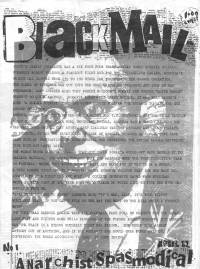INDUSTRIAL Unionism was the driving force behind militant trade unionism in the early nineteen hundreds. The IWW first established a group in Christchurch in 1908. Such personalities as Tom Barker and J B King were active in a group in Auckland in 1912-1913, through the Waihi and General Strikes. They were selling thousands of copies of Industrial Unionist during this period. After the defeat of the 1913 General Strike, Tom Barker was deported and ended up back in England. King retumed to Sydney. He spoke at a May Day meeting in Wellington in 1932 in defence of Sacco-Vanzetti.
There was a small Anarcho-Communist group in Wellington in 1912. Street fights with police frequently occurred after meetings. A Polish baker called Josephs was involved in this group.
During the 30's there seems to be individuals who were very active. The Webb family in Auckland and another individual in Wellington. All I know of him was that he was well-dressed and carried a copy of Bakunin's writings around with him.
Jock Barnes was thinking along syndicalist lines after Savage conveniently forgot to get him a job after the 1935 Labour win. (Jock Barnes was later a leader of the 1951 waterfront strike). There was a Libertarian Socialist Group in Auckland during the late fifties and the sixties. Of course, there were the exiles from Spain - however, few remained active. One person, Werner Droscher, died a few years ago. He left Germany with the rise of Hitler and fought in Spain. Werner was active right up until he died but described himself as a 'retired' anarchist.
THERE are four main areas worth describing: 1 Lumpen street culture; 2 Non- ideological communal groups; 3 Protest movements; 4 @ politicos.
In Wellington a young group with 'punk' connections. Involved with street culture activities, screen printing, anti- Truxton (US nuclear warship) actions. The magazines Fascism & Boredom and Black-out come from there. The individuals however have been subject to much recent police harassment. Political individuals of older ages tend to be heavily influenced by vanguardist and Lemmingist tendencies that proliferate in the bad vibes emanating from parliament and the downtown office complexes.
 Christchurch, or more affectionately known as smogland. A new print shop has been established - offset A3 size printing. Also premises for lay-out, screenprinting, darkroom and workshop. A library , one issue of Blackmail, posters, and two issues of South-East News (for local letter boxing) printed. Irregular meetings but a continuity of commitment. The individuals have experience of subversive activities ranging from over a decade to a few months. This diversity of ages and backgrounds brings in new ideas and energies -all largely within the anarcho-communist ideological spectrum. We are playing on exposing local work, corruption housing, LPG issues as well as general anti-commentaries and ideas on how to survive. Contact with overseas groups is good and a literature importation and distribution service well-organised.
Christchurch, or more affectionately known as smogland. A new print shop has been established - offset A3 size printing. Also premises for lay-out, screenprinting, darkroom and workshop. A library , one issue of Blackmail, posters, and two issues of South-East News (for local letter boxing) printed. Irregular meetings but a continuity of commitment. The individuals have experience of subversive activities ranging from over a decade to a few months. This diversity of ages and backgrounds brings in new ideas and energies -all largely within the anarcho-communist ideological spectrum. We are playing on exposing local work, corruption housing, LPG issues as well as general anti-commentaries and ideas on how to survive. Contact with overseas groups is good and a literature importation and distribution service well-organised.
While the number of self-proclaimed @'s in NZ is small and almost exclusively male and pakeha the potential for future activity is good. Long-standing dissatisfaction with the Govt and business is widespread and the various protest and industrial actions over the past decade have created a tradition of struggle that has many anti-authoritarian aspects.
Tu Kana te manu kia rere,
Christchurch, New Zealand